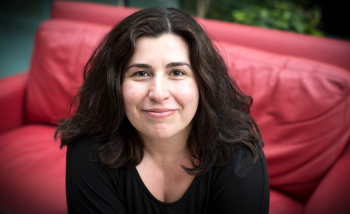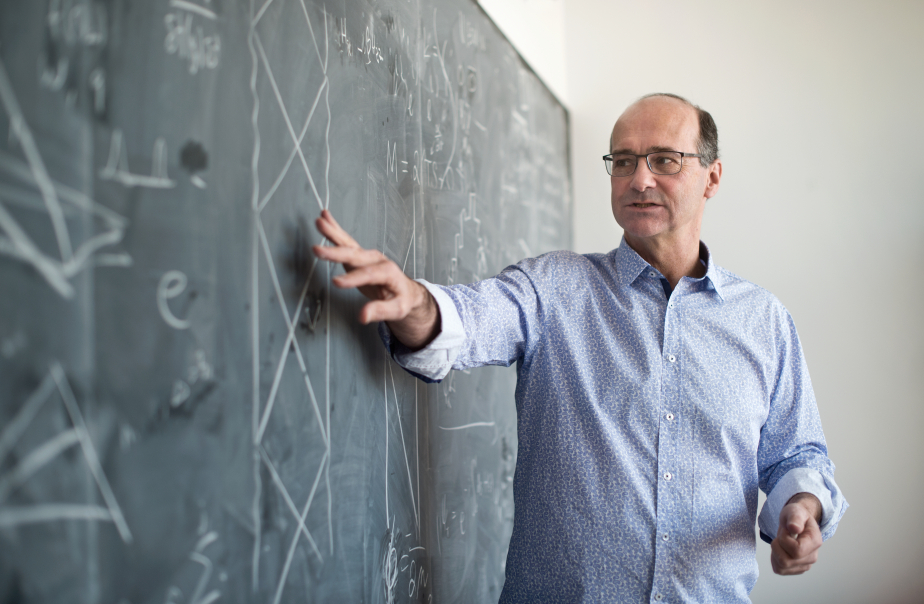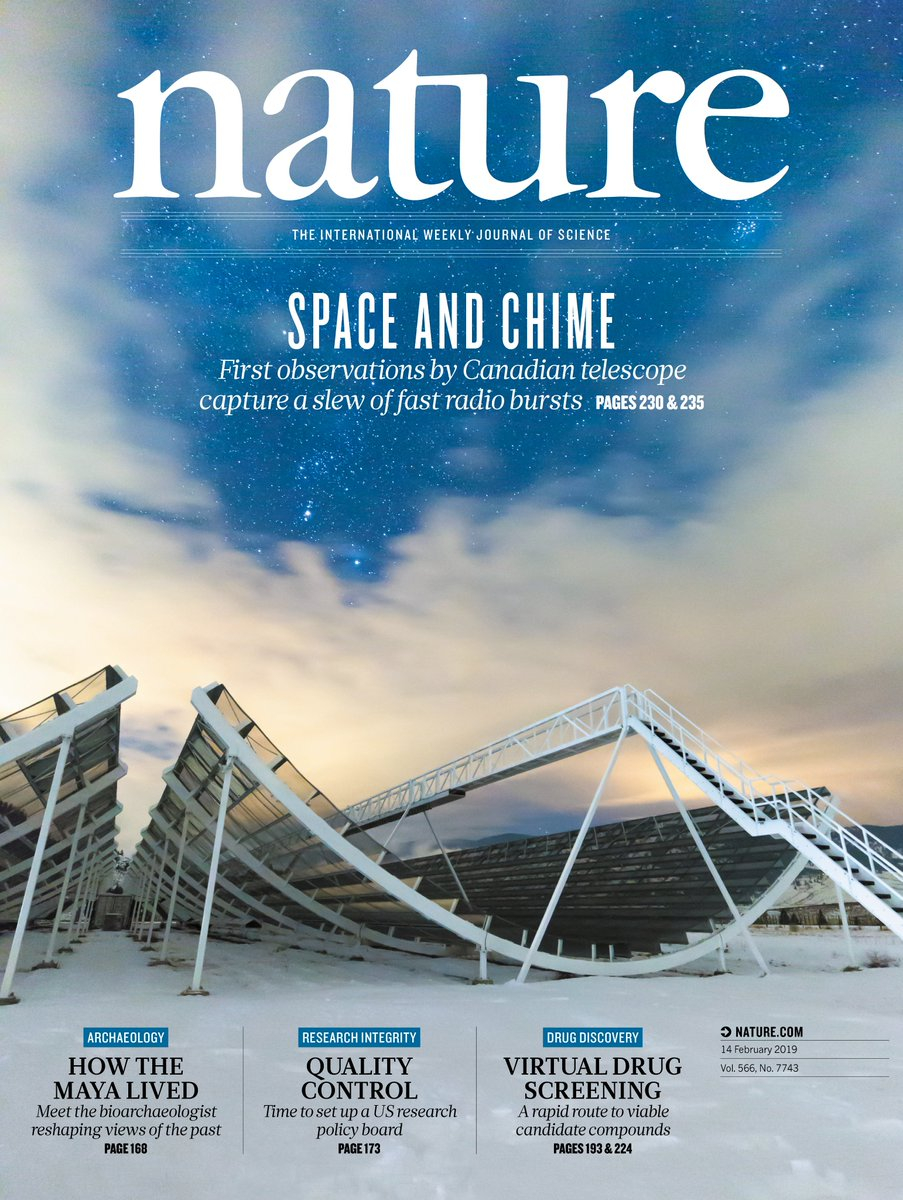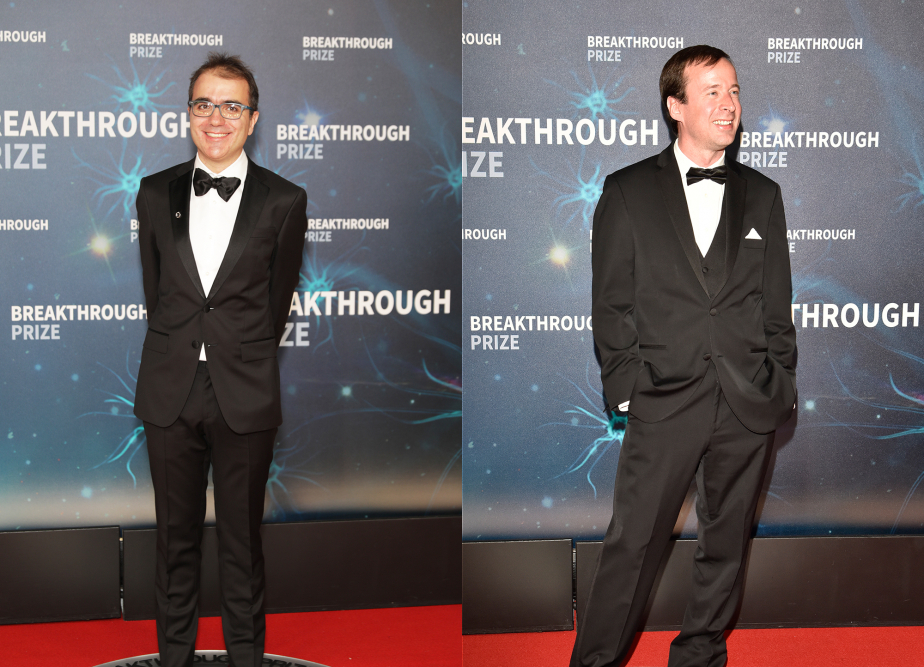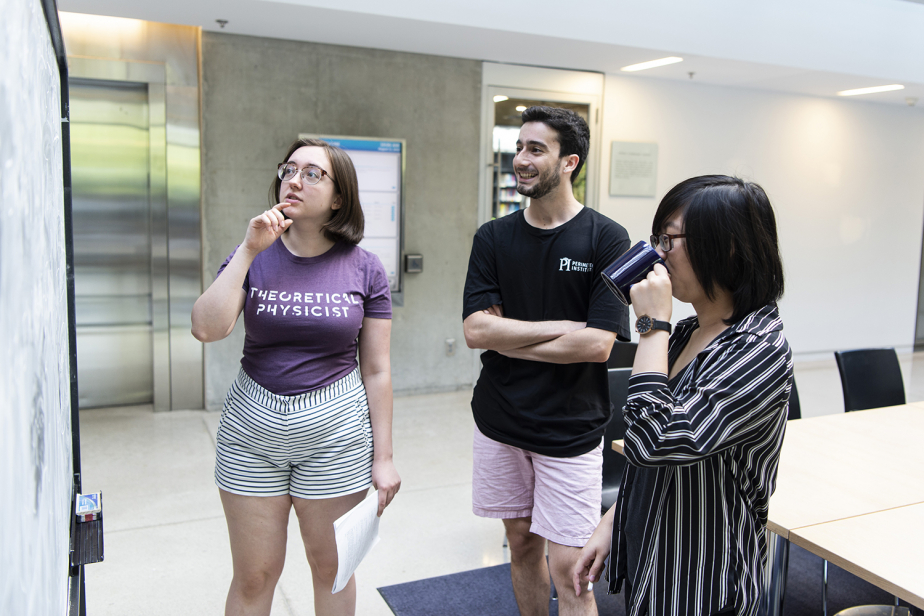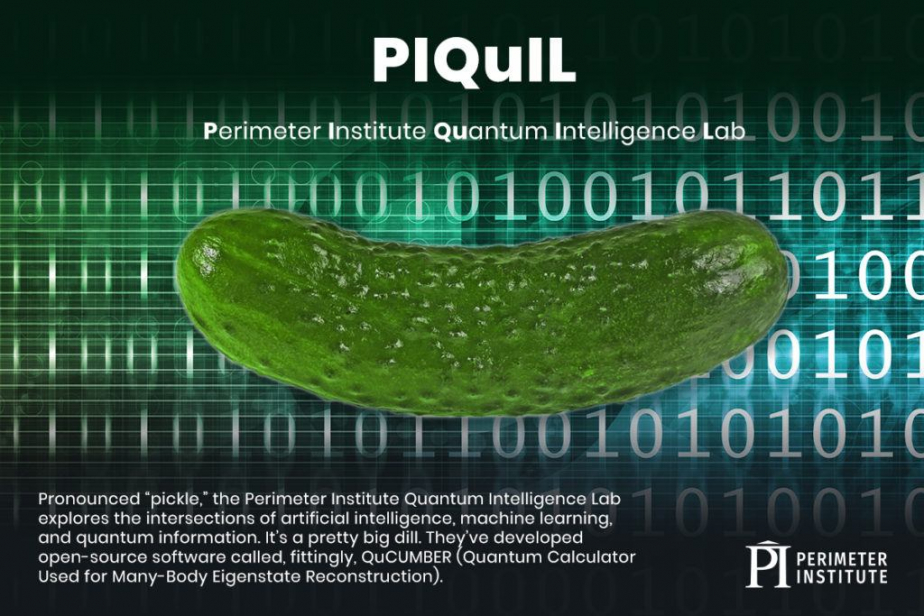ROB MYERS NAMED PERIMETER’S NEW DIRECTOR
After an exhaustive international search, theoretical physicist Robert Myers was appointed the new Director of Perimeter Institute in February. Myers is the most cited researcher at Perimeter, and is a globally respected quantum theorist regarded as a giant in his field.
His appointment follows the 10-year directorship of Neil Turok, who remains at Perimeter as a full-time researcher leading the Institute’s new cosmology research hub, the Centre for the Universe at Perimeter Institute.
Myers, who joined Perimeter in 2001 as a founding faculty member, said he hopes to inspire his colleagues every day to embrace the ideals on which Perimeter was founded. “Be bold, be adventurous, be audacious in our aspirations to advance humanity through exceptional science,” said Myers.
SEEING THE UNSEEABLE
After decades of speculation, theory, and indirect observation, 2019 marked the year we finally obtained visual proof: black holes exist. In April, the Event Horizon Telescope (EHT) collaboration revealed the astonishing — and now iconic — first image of a black hole. The round black shadow against a swirl of brilliant light shows the event horizon of the black hole that lies at the heart of the M87 galaxy in the Virgo cluster.
The EHT linked eight experimental facilities (and hundreds of researchers, including Avery Broderick, who holds the Delaney Family John Archibald Wheeler Chair at Perimeter Institute) to create what is, essentially, an Earth-sized telescope with an angular resolution of 20 microarcseconds – resolution great enough to read the fine print on a dime in South Africa from a vantage point in New York City. The achievement earned the team the prestigious Breakthrough Prize and was named breakthrough of the year by Science.
HEARING THE BRIEFEST CHIMES
That wasn’t the only astronomical milestone reached in 2019. In January, scientists working at CHIME (the Canadian Hydrogen Intensity Mapping Experiment) announced the detection of an unprecedented number of fast radio bursts (FRBs). These brief blasts of radio waves from distant galaxies are one of the current unsolved mysteries of astrophysics: their origins are unknown and are the subject of much theoretical research.
Prior to CHIME, only several dozen FRBs had been detected over the decade since their discovery; CHIME discovered 13 new FRBs (including the second-ever repeating signal) shortly after being turned on for its first pre-commissioning phase, running at only a fraction of its full capacity. The work captured global headlines — including the cover of Nature – but that wasn’t the end of the story. In August, they announced a second, much larger batch that, excitingly, contained eight more repeaters.
The rapid-fire progress has been spurred by CHIME’s software, primarily developed by Perimeter Faculty member Kendrick Smith and his growing team at Perimeter. “We call CHIME a software telescope,” said Smith, who holds the Daniel Family James Peebles Chair at Perimeter. “We basically turned high-precision radio astronomy into a software problem.”
DISENTANGLING CAUSE-AND-EFFECT, QUIRKS OF QUARKS, AND AN ALL-POWERFUL QUANTUM JUICER
Perimeter researchers also made progress on the other (smaller) end of the scale, puzzling out particles and their quantum strangeness.
Predicting the behaviour of, say, a pen rolling across a desk can be done with high school physics. But what about predicting the behaviour of the quarks and gluons that make up the protons and neutrons of the pen, and other everyday matter? That’s quite a bit more complicated – often impossible — and is governed by the laws of quantum chromodynamics, or QCD. Jaume Gomis, one of Perimeter’s senior faculty members, took a major step forwards in the field, developing a new mathematical formulation that can be used to predict the dynamics of systems at low energies. It’s a breakthrough that has opened new lines of research by both Gomis and the community, including predictions that can soon be tackled by large-scale computer simulations.
Three quantum foundations researchers (Perimeter Faculty member Robert Spekkens and postdoctoral fellows Tobias Fritz and Elie Wolfe) introduced a new technique that helps unravel part of causal complexity, teasing apart the messy tangle of cause-and-effect. The trio used approaches inspired by fundamental quantum physics to create a new tool that helps identify which causal accounts of given correlations are viable, and which are not.
And Perimeter postdoctoral researcher Zi-Wen Liu and collaborators developed a framework – the rough quantum equivalent of a multipurpose juicer – that can characterize the practical usefulness of any quantum resource, regardless of type. The work is expected to have broad applicability to fields that use quantum resources, like quantum computing and quantum information.
PERIMETER RESEARCH RECEIVES AWARDS AND ACCOLADES
It was the biggest science story of the year, so it was fitting that the EHT collaboration won the 2020 Breakthrough Prize in Fundamental Physics. The $3 million (USD) prize — the richest in science — will be split equally among 347 astrophysicists across 60 institutions in 20 different countries. Perimeter’s cohort includes Faculty member Avery Broderick; Associate Faculty member Ue-Li Pen; postdoctoral researcher Hung-Yi Pu; PhD student Paul Tiede; and associate PhD students Boris Georgiev, Britton Jeter, and Chunchong (Rufus) Ni.
Perimeter researchers also earned the New Horizons in Physics Prizes, which recognize early career scientists making important progress on fundamental problems. Kendrick Smith and colleagues were honoured for their contributions to CHIME, while Pedro Vieira, who holds the Clay Riddell Paul Dirac Chair at Perimeter, and Visiting Fellow Simon Caron-Huot were recognized for contributions to the understanding of quantum field theory.
Senior Faculty member Jaume Gomis won this year’s CAP-CRM Prize for Theoretical and Mathematical Physics “for his broad range of important contributions to string theory and strongly coupled gauge theories, including the pioneering use of nonlocal observables, the exact computation of physical quantities in quantum field theory, and the unravelling of the nonperturbative dynamics of gauge theories.”
Perimeter Faculty member Kevin Costello won the 2020 Leonard Eisenbud Prize for Mathematics and Physics from the American Mathematical Society (AMS) for his influential work to bring mathematics and physics closer together.
But that wasn’t all. Perimeter researchers Davide Racco and Matthew Johnson were among the winners of the Buchalter Cosmology Prize, marking the fifth consecutive year that multiple Perimeter scientists have been honoured. Meanwhile, PhD student Anna Golubeva was awarded for interdisciplinary research, former PhD student Giacomo Torlai was recognized for outstanding doctoral thesis work, and postdoc Sebastian Steinhaus earned a prestigious research grant.
EMBOLDENING THE CURIOSITY OF YOUTH
This summer, 20 of the world’s top undergraduate students stepped out of the classroom and up to the chalkboards as part of the inaugural Undergraduate Theoretical Physics Summer Program at Perimeter. For two weeks in May, they took in lectures and worked together on real research problems. For 10 of the students, the invitation extended beyond the summer, enabling them to work as assistants with Perimeter researchers.
At the master’s level, Perimeter Scholars International (PSI) reached a major milestone, graduating its 10th cohort of budding theoretical physicists this year. Several researchers involved in the founding of PSI were present at the graduation ceremony to reflect on 10 years of the program.
CONDENSED MATTER THEORIST CHONG WANG JOINS FACULTY
Condensed matter can be a hard sell, even to physicists. But if you stick with it, says condensed matter theorist Chong Wang, something amazing can emerge from the complexity: beauty. Wang is Perimeter’s newest faculty member. Previously, he was at Harvard for a postdoc, and MIT for his PhD. At Perimeter, he is part of a growing focus on “quantum matter” at the Institute, joining other promising young researchers busy probing nature’s quirkier building blocks.
SHARING THE BEAUTY AND FUN OF SCIENCE WITH THE WORLD
At Perimeter, we believe that great science deserves to be shared. This year, Perimeter’s public lecture series took audiences on a voyage to exoplanet homes-away-from-home, played the music of the universe, explored how advances in the physics of light can help us feed the planet, and presented a “graphic” way of sharing complex science. You can watch all the public lectures (plus hundreds of other fun science videos) on Perimeter’s YouTube channel.
When there’s just not quite time to devour a whole lecture, Perimeter’s award-winning “Slice of PI” provides an on-the-go morsel of science. We shared fascinating answers to simple questions, pondered the origin of FRBs, marveled at mirthful monikers, found some great physics podcasts, and quizzed your knowledge of the Milky Way.
The people who do the science are often just as interesting as the science itself. Perimeter’s People of PI series profiled unity seeker Elise LePage, data tinkerer Dustin Lang, gravitational explorer Béatrice Bonga, curious undergrad Gebremedhin Dagnew, and more.
And we just couldn’t see out the year without some new bling. Our “Forces of Nature” series celebrating women in science got three new additions: Maria Goeppert Mayer, who developed a model for the atomic nucleus, Cecelia Payne-Gaposchkin, who determined the composition of stars, and mathematician Katherine Johnson, who worked as a “computer” at NASA. We also upped the ante with two new posters of the EHT’s now-iconic black hole image, and bonus facts about the collaboration.
Plus, this year, our biannual magazine, Inside the Perimeter, took home silver in the “Best Print Magazine” category of the CCAE Awards. You can read the latest issue and keep up to speed with all of Perimeter’s science news at InsideThePerimeter.ca.
À propos de l’IP
L'Institut Périmètre est le plus grand centre de recherche en physique théorique au monde. Fondé en 1999, cet institut indépendant vise à favoriser les percées dans la compréhension fondamentale de notre univers, des plus infimes particules au cosmos tout entier. Les recherches effectuées à l’Institut Périmètre reposent sur l'idée que la science fondamentale fait progresser le savoir humain et catalyse l'innovation, et que la physique théorique d'aujourd'hui est la technologie de demain. Situé dans la région de Waterloo, cet établissement sans but lucratif met de l'avant un partenariat public-privé unique en son genre avec entre autres les gouvernements de l'Ontario et du Canada. Il facilite la recherche de pointe, forme la prochaine génération de pionniers de la science et communique le pouvoir de la physique grâce à des programmes primés d'éducation et de vulgarisation.
Ceci pourrait vous intéresser

Marina Maciel Ansanelli explore la réalité sous-jacente à la théorie quantique
janvier 29, 2025

